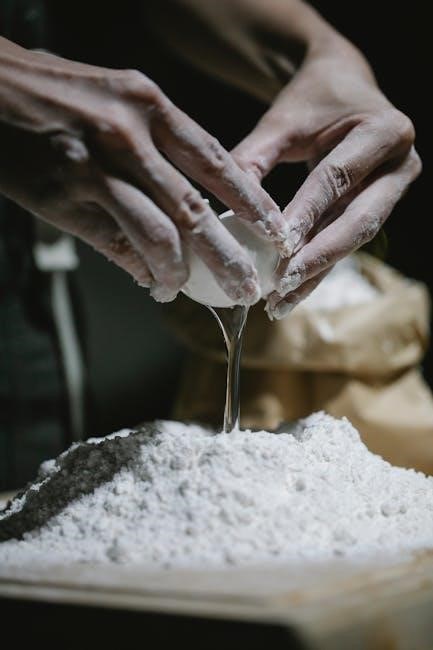
Homemade batteries are simple‚ educational projects using common materials like metals and electrolytes to generate electricity. They offer a fun way to learn about energy storage and conversion.
Overview of Homemade Battery Concepts
Homemade batteries are creative‚ cost-effective solutions for generating electricity using readily available materials. These DIY projects typically involve combining different metals‚ such as copper and aluminum‚ with electrolytes like saltwater‚ vinegar‚ or lemon juice. The concept relies on electrochemical reactions between the metals and the electrolyte‚ producing a small voltage. Homemade batteries can power small devices‚ such as LED lights‚ and serve as educational tools for understanding basic electricity and chemistry principles. They also offer a sustainable way to explore energy storage and conversion‚ making them popular for science projects and eco-friendly initiatives.
Importance of DIY Battery Projects
DIY battery projects are essential for fostering creativity‚ curiosity‚ and hands-on learning in science and technology. They provide a cost-effective way to explore energy storage and conversion‚ making complex concepts accessible. Homemade batteries encourage experimentation with materials and designs‚ promoting problem-solving skills. These projects also highlight the potential for sustainable energy solutions‚ inspiring eco-friendly innovations. By engaging in DIY battery-making‚ individuals gain practical insights into electricity generation and conservation‚ while also developing a deeper appreciation for renewable energy sources and their applications in everyday life.

Understanding the Basics of Batteries
Batteries convert chemical energy into electricity using an anode‚ cathode‚ and electrolyte. The anode oxidizes‚ the cathode reduces‚ and the electrolyte enables ionic flow‚ generating power.
What is a Battery and How Does it Work?
A battery is a device that converts chemical energy into electrical energy through electrochemical reactions. It consists of an anode (negative terminal)‚ cathode (positive terminal)‚ and electrolyte. When connected‚ the anode oxidizes‚ releasing electrons‚ while the cathode reduces‚ accepting electrons. This electron flow creates electricity. The electrolyte facilitates ion transfer between terminals‚ enabling the reaction. Batteries power devices by storing energy‚ making them essential for modern life. Homemade batteries use simple materials like metals and electrolytes to demonstrate these principles‚ offering a hands-on way to explore energy storage and conversion.
Key Components of a Battery: Anode‚ Cathode‚ and Electrolyte
A battery operates through three essential components: the anode‚ cathode‚ and electrolyte. The anode is the negative terminal where oxidation occurs‚ releasing electrons‚ while the cathode is the positive terminal where reduction happens‚ accepting electrons. The electrolyte‚ a conductive material‚ facilitates ion transfer between the anode and cathode without direct contact. Common materials for homemade batteries include metals like zinc or copper for the anode and cathode‚ and saltwater or vinegar as the electrolyte. These components work together to generate electricity‚ enabling the battery to power devices.

Materials Needed for a Powerful Homemade Battery
Common materials include metals like copper‚ aluminum‚ and zinc for electrodes‚ and electrolytes such as saltwater‚ vinegar‚ or lemon juice. Cardboard or paper serves as separators.
Metallic Materials: Copper‚ Aluminum‚ and Zinc
Metallic materials like copper‚ aluminum‚ and zinc are essential for homemade batteries. Copper‚ a highly conductive metal‚ is often used for electrodes due to its excellent electrical properties. Aluminum‚ another popular choice‚ is readily available and reacts well with electrolytes to produce electricity. Zinc‚ known for its high energy density‚ is commonly used as the anode in DIY batteries. These metals are easily sourced from household items‚ making them ideal for homemade battery projects. Their unique properties ensure efficient energy storage and conversion‚ making them crucial components for a powerful homemade battery setup.
Electrolyte Solutions: Saltwater‚ Vinegar‚ and Lemon Juice
Electrolyte solutions like saltwater‚ vinegar‚ and lemon juice are crucial for homemade batteries as they facilitate ionic conduction. Saltwater is a common choice due to its ease of preparation and ability to conduct electricity. Vinegar‚ with its acidic properties‚ enhances the chemical reaction between metals. Lemon juice‚ rich in citric acid‚ also acts as an effective electrolyte. These solutions enable the flow of electrical charge between the anode and cathode‚ making them essential for generating voltage in DIY batteries. While simple‚ they provide a reliable and accessible way to power small devices using everyday materials.
Separators and Insulators: Cardboard‚ Paper‚ and Plastic
Separators and insulators like cardboard‚ paper‚ and plastic play a vital role in homemade batteries by preventing short circuits and ensuring efficient energy flow. These materials act as barriers between the anode and cathode‚ allowing ions to pass through while keeping the electrodes physically separated. Cardboard and paper are commonly used due to their accessibility and ability to absorb electrolytes‚ while plastic can provide a more durable insulation. Proper use of these materials helps maintain the battery’s structure and prevents electrical shorts‚ ensuring safe and reliable operation. They are essential for optimizing the performance of DIY battery designs.

Step-by-Step Guide to Making a Homemade Battery
Assemble materials‚ cut metals‚ and soak separators in electrolytes. Connect wires to terminals‚ ensuring proper insulation. This simple setup generates electricity for small devices.
Preparing the Materials and Tools
Gather materials like copper wire‚ aluminum foil‚ zinc nails‚ and cardboard. Soak cardboard in saltwater or vinegar to create the electrolyte. Cut the materials to size and ensure all surfaces are clean. Use sandpaper to remove oxidation from metals for better conductivity. Collect tools such as scissors‚ a voltmeter‚ and electrical tape. Organize everything in a workspace to streamline assembly. Proper preparation ensures optimal performance and safety during the battery-making process. This step is crucial for achieving a reliable and powerful homemade battery.
Assembling the Battery Components
Begin by soaking cardboard or paper in saltwater or vinegar to create the electrolyte. Cut copper‚ aluminum‚ or zinc into strips and ensure they are clean. Layer the metals with soaked cardboard between them to prevent short circuits. Secure the layers with tape or glue. Connect the copper and zinc terminals using wires‚ ensuring proper polarity. Repeat the layers to increase voltage. Wrap the assembly tightly and test the connections. This method creates a simple yet effective battery stack. Proper alignment and insulation are key to maximizing energy output and safety.
Testing the Battery’s Voltage and Current
Use a voltmeter to measure the battery’s voltage by connecting the positive terminal to the red probe and the negative terminal to the black probe. Record the voltage reading to assess the battery’s power output. To test the current‚ connect the battery to a small device like an LED light or a low-wattage bulb. Observe the brightness to gauge the current flow. Ensure all connections are secure to avoid short circuits. Multiple cells can be connected in series to increase voltage‚ while parallel connections can enhance current. Proper testing helps verify the battery’s efficiency and safety for practical use.
Optimizing the Battery’s Performance
To enhance your homemade battery’s performance‚ experiment with multiple cells connected in series to increase voltage. Use high-surface-area metals like zinc or copper for better conductivity. Improve the electrolyte by adding salts or acids to boost ion flow. Ensure proper insulation between cells to prevent short circuits. Regularly clean and refresh the electrolyte to maintain efficiency. Testing different materials and configurations can significantly improve power output. By refining these elements‚ you can create a more reliable and powerful homemade battery for various applications‚ from lighting small devices to storing energy for renewable sources.

Safety Precautions and Best Practices
Always wear protective gloves and goggles when handling corrosive materials. Avoid short circuits and ensure proper insulation. Dispose of materials responsibly to prevent environmental harm and contamination.
Handling Corrosive Materials and Chemicals
When working with homemade batteries‚ handle corrosive materials like acids or electrolytes with care. Always wear protective gloves and goggles to prevent skin and eye irritation. Ensure good ventilation to avoid inhaling harmful fumes. Avoid direct contact with metals and chemicals‚ as they can cause burns or reactions. Store materials in sealed‚ non-conductive containers away from children. Use insulated tools to prevent accidental shocks. Dispose of waste responsibly‚ following local regulations to protect the environment. Keep the workspace clean and dry to minimize risks of accidents or chemical spills.
Preventing Short Circuits and Overheating
To prevent short circuits‚ ensure all connections are secure and insulated. Use non-conductive materials like plastic or cardboard to separate components. Avoid touching both terminals simultaneously‚ as this can cause unintended electrical paths. Overheating can be minimized by using the correct materials and avoiding excessive current draw. Monitor the battery’s temperature during operation and provide adequate ventilation. Regularly inspect wires and connections for damage or wear. Keep flammable materials away from the battery. Always disconnect the battery when not in use to prevent unintended power drainage or overheating.
Proper Disposal of Battery Materials
Proper disposal of homemade battery materials is crucial for environmental safety. Separate metallic components like copper‚ aluminum‚ and zinc‚ and recycle them through designated programs. Neutralize acidic or corrosive substances like vinegar or saltwater by mixing with baking soda before disposal. Avoid pouring chemicals down drains‚ as they can harm water systems. Insulate wires and store leftover materials in sealed containers. Dispose of non-recyclable items responsibly‚ following local waste guidelines. Always wear protective gear when handling potentially hazardous materials. Ensure all components are safely discarded to minimize environmental impact and prevent contamination.

Applications of Homemade Batteries
Homemade batteries can power small devices‚ LED lights‚ and even vehicles. They provide energy storage for renewable sources and offer sustainable‚ eco-friendly solutions for various applications.
Powering Small Devices and LED Lights
Homemade batteries are ideal for powering small devices like LED lights‚ calculators‚ and low-voltage gadgets. Using simple materials such as coins‚ copper wire‚ and household electrolytes‚ these batteries generate enough voltage to light LEDs or power small electronics. This makes them perfect for educational projects or emergency lighting solutions. By experimenting with different metals and electrolytes‚ you can create a battery capable of powering various small devices‚ demonstrating the fundamental principles of electricity generation. This hands-on approach not only educates but also encourages innovation in energy storage and sustainability.
Energy Storage for Renewable Energy Sources
Homemade batteries can play a role in storing energy generated from renewable sources like solar panels or wind turbines. By creating a rechargeable battery using materials such as metal strips and electrolytes‚ you can store excess energy for later use. This approach is particularly useful for off-grid systems or backup power during outages. While homemade batteries may not match commercial ones in capacity‚ they offer a sustainable and educational way to explore energy storage. Experimenting with different materials and designs can help optimize their performance for renewable energy applications.
Environmental Benefits of Homemade Batteries
Homemade batteries offer eco-friendly advantages by utilizing readily available materials‚ reducing waste‚ and promoting sustainability. They often use natural electrolytes like rainwater or lemon juice‚ minimizing reliance on industrial chemicals. By repurposing household items‚ these batteries help reduce landfill waste and encourage creative reuse of resources. Additionally‚ homemade batteries can store energy from renewable sources‚ supporting off-grid systems and lowering carbon footprints. This DIY approach fosters awareness of energy conservation and inspires innovative solutions for a greener future‚ making it a small but meaningful step toward environmental sustainability.

Advanced Techniques for Enhancing Battery Power
Advanced techniques involve using multiple cells to boost voltage‚ enhancing electrolyte conductivity‚ and experimenting with alternative materials for improved performance and efficiency.
Using Multiple Cells to Increase Voltage
By connecting multiple battery cells in series‚ you can significantly increase the overall voltage. Each cell contributes its voltage to the total output‚ making the battery more powerful. For example‚ using copper and zinc as electrodes in a saltwater electrolyte‚ you can create a simple cell. Stacking several of these cells together amplifies the voltage‚ enabling the battery to power more demanding devices. This method is cost-effective and educational‚ demonstrating how scalable energy storage works. It’s a practical way to enhance homemade batteries for various applications‚ from small gadgets to larger energy needs.
Improving the Electrolyte’s Conductivity
Enhancing the electrolyte’s conductivity is crucial for maximizing a homemade battery’s performance. Using solutions like saltwater‚ vinegar‚ or lemon juice as electrolytes provides ions for current flow. To improve conductivity‚ experiment with different concentrations or additives‚ such as increasing salt in saltwater or mixing acids. Higher conductivity allows for better electron transfer‚ resulting in higher voltage and current. However‚ be cautious‚ as overly conductive solutions may reduce battery life or cause corrosion. Balancing conductivity and material compatibility ensures optimal performance and longevity for your homemade battery.
Experimenting with Alternative Materials
Exploring alternative materials can significantly enhance the performance of homemade batteries; Instead of traditional metals like copper or zinc‚ consider using graphite‚ stainless steel‚ or even activated charcoal for electrodes. For electrolytes‚ natural sources like lemon juice or vinegar can be substituted with conductive gels or ionic liquids. Additionally‚ household items such as saltwater-soaked paper or cloth can serve as separators. Experimenting with these materials can improve voltage‚ current‚ and overall efficiency. However‚ always test new materials cautiously to avoid corrosion or unexpected reactions‚ ensuring safety and reliability in your homemade battery designs.

Case Studies and Real-World Examples
Real-world examples include DIY water cell batteries powering homes and cars‚ showcasing practical applications of homemade energy solutions for sustainable and innovative electricity generation.
Success Stories of DIY Battery Projects
DIY battery projects have shown remarkable success‚ with homemade water cell batteries powering cars and home lighting. One project achieved 1.44V using a copper anode‚ demonstrating practical energy generation. These examples highlight the potential of DIY batteries to provide sustainable solutions. By using common materials like copper‚ aluminum‚ and saltwater‚ enthusiasts have created functional batteries for small devices and even renewable energy storage. Such successes inspire further experimentation and education in energy storage‚ proving that homemade batteries can be both innovative and effective.
Research and Development in Homemade Batteries
Research in homemade batteries focuses on optimizing materials and designs for better performance. Scientists at Argonne National Laboratory inspire DIY projects by experimenting with metals and electrolytes to enhance battery efficiency. Studies show that using copper anodes and saltwater electrolytes can achieve voltages up to 1.44V‚ demonstrating potential for practical applications. Additionally‚ exploring alternative materials like aluminum foil and activated charcoal in saltwater solutions has opened new avenues for sustainable energy storage. These advancements highlight the importance of DIY research in driving innovation and improving battery technology for everyday use.
Expert Tips and Tricks from Scientists
Scientists recommend optimizing homemade battery performance by experimenting with high-conductivity materials and electrolytes. Using copper anodes‚ for instance‚ can achieve up to 1.44V‚ as demonstrated in some DIY projects. Researchers suggest testing different metal combinations and electrolyte solutions to maximize voltage and current. Additionally‚ experts advise proper insulation and avoiding short circuits to ensure safety and efficiency. These tips‚ inspired by studies at institutions like Argonne National Laboratory‚ encourage innovation and improvement in homemade battery designs‚ making them more practical for everyday applications.

Troubleshooting Common Issues
Troubleshooting homemade batteries involves identifying low voltage issues‚ addressing corrosion‚ and resolving connectivity problems. Regular maintenance and proper material selection can enhance performance and longevity.
Identifying and Fixing Low Voltage Output
Low voltage output in homemade batteries is often due to weak electrolytes or improper metal combinations. To fix this‚ ensure the metals used have a significant voltage difference and the electrolyte is conductive. Saltwater or lemon juice can be effective‚ but distilled water lacks conductivity. Increasing the surface area of the metals or adding more cells in series can boost voltage. Additionally‚ check for poor connections or corrosion‚ as these can reduce efficiency. Experimenting with different materials and configurations can help optimize performance and achieve higher voltage outputs for powering small devices or LED lights.
Addressing Corrosion and Material Degradation
Corrosion and material degradation are common issues in homemade batteries‚ reducing efficiency and lifespan. To address this‚ use metals like copper‚ zinc‚ or aluminum‚ which are less prone to rapid corrosion. Coating metals with a protective layer or using non-reactive materials can help. Regularly cleaning the metal surfaces before assembly and ensuring the electrolyte is not overly corrosive are essential; Storing the battery in a dry environment when not in use can also prevent degradation. Experimenting with anti-corrosion coatings or inert materials can further enhance durability and performance of the battery over time.
Solving Connectivity and Short Circuit Problems
Connectivity issues and short circuits are common challenges in homemade batteries. To prevent short circuits‚ ensure all metal components are properly insulated and not touching each other. Use non-conductive materials like plastic or cardboard to separate terminals. Regularly check wires and connections for exposed metal‚ which can cause unintended paths for electricity. Testing the battery with a multimeter can help identify short circuits before they cause damage. Improving connectivity involves securing wires tightly to terminals and ensuring clean‚ direct paths for current flow. Proper insulation and secure connections are key to maintaining safety and efficiency in your homemade battery.

Future Possibilities in Battery Technology
Emerging trends in energy storage highlight the potential for homemade batteries to contribute to sustainable solutions. Innovative materials and designs could enhance efficiency and scalability‚ fostering greener energy alternatives.
Emerging Trends in Energy Storage
Emerging trends in energy storage focus on sustainable and innovative solutions‚ with homemade batteries playing a role in eco-friendly power generation. Researchers are exploring water-based batteries using rainwater or saltwater as electrolytes‚ which are environmentally friendly and cost-effective. These designs leverage common materials like copper‚ aluminum‚ and zinc‚ paired with household electrolytes such as vinegar or lemon juice. Such systems can store energy for renewable sources‚ offering a decentralized power solution. While simple‚ these DIY batteries demonstrate the potential for grassroots contributions to energy storage advancements‚ inspiring further research and development in sustainable battery technology.
The Role of Homemade Batteries in Sustainability
Homemade batteries play a significant role in promoting sustainability by utilizing eco-friendly materials and reducing reliance on industrial production. They often use rainwater‚ saltwater‚ or natural electrolytes like lemon juice‚ minimizing environmental impact. These DIY projects encourage recycling of household items‚ such as metals and plastics‚ reducing waste. By providing a low-cost‚ accessible way to store energy‚ homemade batteries support renewable energy systems and offer a decentralized power solution. They also educate individuals about energy conservation and chemistry‚ fostering a culture of sustainability and innovation in energy storage.
Innovative Materials for Next-Generation Batteries
Next-generation homemade batteries are exploring innovative materials to enhance performance and sustainability. Researchers are experimenting with activated charcoal‚ saltwater‚ and natural electrolytes like lemon juice to improve conductivity. Alternative metals such as zinc and aluminum are being combined with eco-friendly separators like paper or cardboard. These materials not only reduce costs but also minimize environmental impact. Additionally‚ scientists are investigating the use of recycled metals and biodegradable components to create more sustainable battery solutions. Such innovations could pave the way for greener energy storage systems and DIY projects that are both powerful and environmentally friendly.
Homemade batteries offer a fun‚ educational way to explore energy storage. With simple materials‚ anyone can create a powerful battery‚ inspiring further experimentation and innovation.
Summarizing the Key Takeaways
Making a powerful homemade battery involves using readily available materials like metals (copper‚ aluminum) and electrolytes (saltwater‚ vinegar). These components work together to generate electricity through chemical reactions. The process is simple yet educational‚ teaching fundamental principles of energy storage. Safety precautions‚ such as handling corrosive materials and avoiding short circuits‚ are essential. Homemade batteries can power small devices‚ offering a sustainable and cost-effective solution. Experimentation with different materials and designs can enhance performance‚ making DIY batteries a fun and innovative project for learners of all ages.
Encouraging Further Exploration and Experimentation
Exploring homemade battery projects encourages creativity and a deeper understanding of energy storage. Experiment with different metals‚ electrolytes‚ and designs to optimize performance. Try varying the number of cells or testing alternative materials like lemon juice or vinegar. Documenting your experiments can provide valuable insights and inspire others. Share your projects online or in science fairs to foster innovation. Remember‚ DIY batteries not only teach fundamental science but also promote sustainability. Keep experimenting—every trial brings you closer to creating a more powerful and efficient homemade battery!